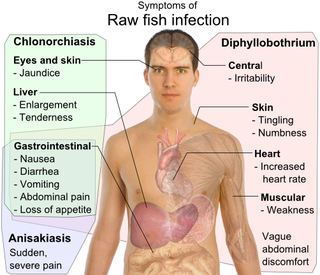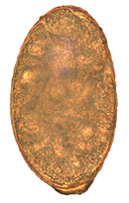
Trematoda is a class within the phylum Platyhelminthes. It includes two groups of parasitic flatworms, known as flukes.

Clonorchis sinensis, the Chinese liver fluke, is a liver fluke belonging to the class Trematoda, phylum Platyhelminthes. It infects fish-eating mammals including humans. In humans, it infects the common bile duct and gall bladder, feeding on bile. It was discovered by a British physician James McConnell at the Medical College Hospital in Calcutta (Kolkata) in 1874. The first description was given by Thomas Spencer Cobbold, who named it Distoma sinense. The fluke passes its life cycle in three different hosts, namely freshwater snail as first intermediate hosts, freshwater fish as second intermediate host, and mammals as definitive hosts.

Digenea is a class of trematodes in the Platyhelminthes phylum, consisting of parasitic flatworms with a syncytial tegument and, usually, two suckers, one ventral and one oral. Adults commonly live within the digestive tract, but occur throughout the organ systems of all classes of vertebrates. Once thought to be related to the Monogenea, it is now recognised that they are closest to the Aspidogastrea and that the Monogenea are more closely allied with the Cestoda. Around 6,000 species have been described to date.

Clonorchiasis is an infectious disease caused by the Chinese liver fluke, Clonorchis sinensis, and two related species. Clonorchiasis is a known risk factor for the development of cholangiocarcinoma, a neoplasm of the biliary system.
Microphallus is a genus of parasitic trematodes (flukes) in the family Microphallidae. The Greek name means "tiny penis".

Fasciola gigantica is a parasitic flatworm of the class Trematoda, which causes tropical fascioliasis. It is regarded as one of the most important single platyhelminth infections of ruminants in Asia and Africa. Estimates of infection rates are as high as 80–100% in some countries. The infection is commonly called fasciolosis.

Trematodes are parasitic flatworms of the class Trematoda, specifically parasitic flukes with two suckers: one ventral and the other oral. Trematodes are covered by a tegument, that protects the organism from the environment by providing secretory and absorptive functions.

Paragonimus westermani is the major species of lung fluke that infects humans, causing paragonimiasis. The species sometimes is called the Japanese lung fluke or oriental lung fluke. Human infections are most common in eastern Asia and in South America. Paragonimus westermani was discovered when two Bengal tigers died of paragonimiasis in zoos in Europe in 1878. Several years later, infections in humans were recognised in Formosa.

Echinostoma is a genus of trematodes, which can infect both humans and other animals. These intestinal flukes have a three-host life cycle with snails or aquatic organisms as intermediate hosts, and a variety of animals, including humans, as their definitive hosts.

Paragonimiasis is a food-borne parasitic infection caused by the lung fluke, most commonly Paragonimus westermani. It infects an estimated 22 million people yearly worldwide. It is particularly common in East Asia. More than 30 species of trematodes (flukes) of the genus Paragonimus have been reported; among the more than 10 species reported to infect humans, and only 8 bringing about infections in humans, the most common is P. westermani, the oriental lung fluke.
Brachylaima is a genus of trematodes. It has recently been discovered that it can infest the gastrointestinal tract of human beings.
Metagonimoides oregonensis is a trematode, or fluke worm, in the family Heterophyidae. This North American parasite is found primarily in the intestines of raccoons, American minks, frogs in the genus Rana, and freshwater snails in the genus Goniobasis. It was first described in 1931 by E. W. Price. The parasite has a large distribution, from Oregon to North Carolina. Adult flukes vary in host range and morphology dependent on the geographical location. This results in different life cycles, as well as intermediate hosts, across the United States. On the west coast, the intermediate host is freshwater snails (Goniobasis), while on the east coast the intermediate host is salamanders (Desmognathus). The parasites on the west coast are generally much larger than on the east coast. For example, the pharynx as well as the body of the parasite are distinctly larger in Oregon than in North Carolina. The reverse pattern is observed on the east coast for uterine eggs, which are larger on the west coast. In snails, there is also a higher rate of infection in female snails than in males. Research on the life history traits of the parasites have been performed with hamsters and frogs as model species.

Nanophyetus salmincola is a food-borne intestinal trematode parasite prevalent on the Pacific Northwest coast. The species may be the most common trematode endemic to the United States.

Echinostoma revolutum is a trematode that can be parasitic in humans. It causes the disease echinostomiasis.
Echinostoma hortense is an intestinal fluke of the class Trematoda, which has been found to infect humans in East Asian countries such as Korea, China, and Japan. This parasite resides in the intestines of birds, rats and other mammals such as humans. While human infections are very rare in other regions of the world, East Asian countries have reported human infections up to about 24% of the population in some endemic sub-regions. E. hortense infections are zoonotic infections, which occurs from eating raw or undercooked freshwater fish. The primary disease associated with an E. hortense infection is called echinostomiasis, which is a general name given to diseases caused by Trematodes of the genus Echinostoma.

Clinostomum marginatum is a species of parasitic fluke. It is commonly called the "yellow grub". It is found in many freshwater fish in North America, and no fish so far is immune to this parasite. It is also found in frogs. Clinostomum marginatum can also be found in the mouth of aquatic birds such as herons and egrets. They are commonly present in the esophagus of fish-eating birds and reptiles. Eggs of these trematodes are shed in the feces of aquatic birds and released into water. Aquatic birds become hosts of this parasite by ingesting infected freshwater fish. The metacercariae are found right beneath the skin or in the muscles of host fish.
Megalodiscus temperatus is a Digenean in the phylum Platyhelminthes. This parasite belongs to the Diplodiscidae family and is a common parasite located in the urinary bladder and rectum of frogs. The primary host is frogs and the intermediate hosts of Megalodiscus temeperatus are freshwater snails in the genus Helisoma.
Coitocaecum parvum is a digeneic trematode or flatworm (Platyhelminthes) that is parasitic to the intestine of the common bully or upland bully. The common and upland bully are freshwater fish of New Zealand that C. parvum uses as its definitive host. C. parvum is a hermaphroditic freshwater trematode that can omit its definitive host and produce eggs by selfing or progenesis inside its amphipod second intermediate host
Alaria americana is a species of a trematode in a family Diplostomidae. All of these species infect carnivorous mammals by living in their small intestines as mature worms. A. americana are most frequently found in temperate regions, predominately in northern North America. This organisms habit is extremely diverse, as it occupies four different hosts throughout its lifetime. This trematode thrives in areas close to water as it is needed for several developmental stages to occur. A. americana has been isolated to the different North American mammals with a wide range of definitive hosts, including cattle, lynx, martens, skunks, bobcats, foxes, coyotes, and wolves.

Metagonimus yokogawai is a species of a trematode, or fluke worm, in the family Heterophyidae.












